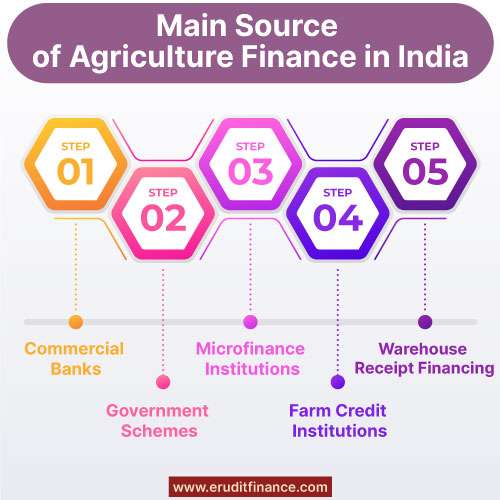Farming progress hangs on getting enough money. Agro-finance helps out big time, as it answers the different needs of farmers and agro-companies. We’re looking at where farmers can get this money, from bank loans to fresh new options, and why they are so important. They give farmers the cash needed to get better at what they do, use new tech, and handle farming’s tough parts. Knowing about these Source of Agriculture Finance which lead to more farming growth and food for all.
What Is Agricultural in Finance?
“Agricultural finance” means special financial services customized to suit the specific demands of people and businesses in agriculture. This includes various financial aids that assist agricultural actions like farming, livestock, and associated agribusinesses. “Agricultural finance” covers a wide array of services.
Some examples are loans to buy equipment, seeds, or livestock, crop insurance, and financing for working capital. They also provide other financial items focusing on encouraging sustainable and profitable farming customs. This aims to give farmers and agribusinesses vital capital and risk management aids to boost productivity. It also helps maintain the stability of the farming sector.
What Are the Main Source of Agriculture Finance in India?
In India, agricultural finance is crucial for sustaining the livelihoods of millions of farmers. Various sources cater to the diverse financial needs of the agricultural sector. The main sources of agricultural finance in India include
| Commercial Banks | Government Schemes | Agricultural Credit Cooperatives |
| Farm Credit Institutions | Microfinance Institutions | Regional Rural Banks (RRBs) |
| NABARD | Cooperative Credit Institutions | Agricultural Insurance Companies |
| Warehouse Receipt Financing | Microfinance Institutions | Non-Banking Financial Companies |
a). Commercial Banks- Traditional lenders, such as commercial banks, provide agricultural loans for various purposes, including crop cultivation, purchase of machinery, and investment in allied activities.
b) Regional Rural Banks (RRBs)- RRBs are financial institutions specifically designed to cater to the rural and agricultural sectors. They offer a range of financial services, including crop loans and agricultural development loans.

c). Cooperative Credit Institutions- Cooperative banks and credit societies play a significant role in agricultural finance. They provide credit to farmers at reasonable interest rates and often operate at the grassroots level.
d). NABARD (National Bank for Agriculture and Rural Development)- NABARD is a specialized development bank that focuses on agriculture and rural development. It extends financial support to various institutions involved in agricultural activities, including farmers, cooperatives, and rural banks.
e). Microfinance Institutions- Microfinance institutions offer small-ticket loans to farmers and rural entrepreneurs. These loans contribute to financial inclusion in remote areas where traditional banking services may be limited.
f). Government Schemes- The Indian government introduces various schemes and programs to support farmers, providing subsidized credit, interest rate concessions, and debt relief. Examples include the Kisan Credit Card (KCC) scheme and Pradhan Mantri Fasal Bima Yojana (PMFBY).
g). Agricultural Credit Cooperatives- Cooperative societies dedicated to agriculture provide financial assistance to farmers. They operate on cooperative principles, with members contributing to the pool of funds.
h). Non-Banking Financial Companies (NBFCs)- Some NBFCs focus on agricultural finance, offering tailored products such as equipment loans, working capital loans, and crop insurance.
i). Agricultural Insurance Companies- Insurance companies specializing in agriculture provide crop insurance to protect farmers from financial losses due to natural calamities, pests, or diseases.
j). Farm Credit Institutions- Institutions like the Small Farmers’ Agri-Business Consortium (SFAC) work towards promoting agribusiness and providing financial assistance to small and marginal farmers.
k). Warehouse Receipt Financing- Farmers can use warehouse receipts for commodities stored in warehouses as collateral to secure loans. This form of financing helps farmers access credit while waiting for better market prices.
l). Private Agribusiness Companies- Some private companies engaged in agribusiness provide financing to farmers as part of their supply chain and procurement processes.
Understanding and leveraging these diverse sources of agricultural finance is crucial for enhancing the economic sustainability and productivity of the agriculture sector in India.
Why Is Agricultural Finance Important in India?
Agricultural finance holds immense importance in India for several compelling reasons.
| Livelihood Sustenance | Market Linkages | Rural Development |
| Technology Adoption | Debt Relief | Support Programs |
| Crop Cultivation and Diversification | Risk Mitigation through Insurance | Investment in Inputs & Farm Mechanization |
Technology Adoption- Access to finance facilitates the adoption of modern agricultural technologies and machinery, enhancing efficiency, increasing yields, and promoting sustainable farming practices.
Risk Mitigation through Insurance- Agricultural finance supports the implementation of crop insurance schemes. This helps farmers manage risks associated with unpredictable factors such as weather conditions, pests, and diseases, providing a safety net for their investments.

Infrastructure Development- The financing aspect plays a role, in advancing infrastructure, such as irrigation systems, storage facilities, and transportation networks. By improving the infrastructure the efficiency of the agricultural value chain is enhanced.
Investment in Inputs & Farm Mechanization- Farmers greatly benefit from assistance in acquiring high-quality inputs like seeds, fertilizers, and pesticides. Moreover, loans enable them to mechanize farming operations reducing the reliance on labor and boosting productivity.
Debt Relief & Support Programs- Government initiatives and financial institutions often provide debt relief and support programs to alleviate the financial burden on farmers. These programs aim to enhance the financial resilience of farmers facing economic challenges.
Market Linkages- It facilitates better market linkages for farmers. With financial support, farmers can store their produce, wait for favorable market conditions, & access markets beyond their immediate vicinity.
Rural Development- A strong agricultural finance system plays a role, in the development of rural areas. It helps stimulate activities create job opportunities increase income levels and support the establishment of agribusinesses.
Who Is the Father of Agricultural Finance in India?
Lots of folks in India depend on farming for money. It’s super important to help these farmers. By doing this, they can take care of themselves and their loved ones. This also boosts the health and happiness of countryside folks.
Nobody is known as the “Dad of Farm Finance” in India. The growth of farm finance in India has seen many influences. Lots of policy creators, scholars, and chiefs across time had a part in forming this field. A big player in the farm finance area in India is the National Bank for Agriculture and Rural Development (NABARD). They’ve been vital in shaping the future of finance for farming and rural areas.
The National Bank for Agriculture and Rural Development, or NABARD, was set up in 1982. It’s a special finance establishment for rural development and agriculture. It’s vital because it’s been carrying out and supervising countless plans. These plans ensure farmers get financial aid, help grow the common rural structure, and stimulate overall countryside advancement. Though NABARD isn’t a person, it’s a key body in India’s farm finance sector.
What Are the Financial Schemes for Farmers in India?
India has implemented several financial schemes to support farmers and enhance agricultural productivity. Some prominent financial schemes for farmers in India include
Pradhan Mantri Kisan Samman Nidhi (PM-KISAN)
Kisan Credit Card (KCC) Scheme
Pradhan Mantri Fasal Bima Yojana (PMFBY)
National Mission on Sustainable Agriculture (NMSA)
Interest Subvention Scheme for Short-Term Crop Loans
Rashtriya Krishi Vikas Yojana (RKVY)
Pradhan Mantri Krishi Sinchayee Yojana (PMKSY)
Paramparagat Krishi Vikas Yojana (PKVY)
National Food Security Mission (NFSM)
National Food Security Mission (NFSM)
Integrated Scheme for Agricultural Marketing (ISAM)
A direct income support scheme providing eligible farmers with a fixed financial assistance of Rs. 6,000 per year in (3)three equal installments.
Provides farmers with access to credit for agricultural and allied activities. It allows farmers to draw money as a cash loan or use it through a credit card for purchasing inputs.
A crop insurance scheme aimed at providing financial protection to farmers in case of crop loss due to natural calamities, pests, or diseases.
Promotes sustainable agriculture practices and provides financial assistance for various activities, including organic farming, soil health management, and water-use efficiency.
Offers interest subvention to farmers who repay short-term crop loans promptly, effectively reducing the cost of credit.
A centrally sponsored scheme that aims to achieve growth in agriculture and allied sectors by providing financial assistance for projects related to infrastructure, research, and extension services.
Aims to enhance water use efficiency in agriculture by providing financial support for the development of water sources, distribution networks, and efficient water application technologies.
Promotes organic farming by providing financial assistance for the adoption of organic practices and certification.
Focuses on increasing the production of rice, wheat, pulses, and coarse cereals by providing financial assistance for various interventions, including technology adoption and seed distribution.
Aims to provide farmers with information on the nutrient status of their soil and recommendations for appropriate fertilizers, thereby improving soil health and crop productivity.
Supports the creation of agricultural marketing infrastructure and provides financial assistance for the development of market facilities.
Bottomline
In conclusion, the diverse Source of Agriculture Finance serves as vital pillars supporting the backbone of India’s rural economy. From traditional banking institutions to specialized agricultural development agencies, these sources contribute to the financial resilience and growth of farmers and agribusinesses. The financial instruments have to be aligned by understanding the nuances of available options in tune with the related sector’s needs while navigating the agricultural finance landscape successfully. Thus, through continued focus on innovation, inclusivity, and sustainable practice, the changing scene across agricultural financing remains central to ensuring prosperity in the agrarian communities of India while also fostering their food security.
Source Of Agriculture Finance(FAQs)
- Formal Sources: Banks, microfinance institutions, government schemes, cooperatives, and agricultural credit institutions.
- Informal Sources: Moneylenders, traders, commission agents, and family or friends.
- Developmental Sources: International organizations (World Bank, IMF, FAO), NGOs, and government subsidies.
- Short-term loans- For seasonal expenses like seeds, fertilizers, and pesticides.
- Medium-term loans- For purchasing machinery, irrigation systems, and livestock.
- Long-term loans- For infrastructure development such as farm buildings and land purchases.
- Subsidized agricultural loans from banks.
- Grants and financial aid from government programs.
- Crop insurance schemes.
- Agricultural development funds.
- Direct loans for agricultural inputs and equipment.
- Credit facilities like Kisan Credit Cards (KCC) in some countries.
- Investment support for agribusiness ventures.
- Group-based lending schemes.
- Flexible repayment options.
- Financial literacy programs.










